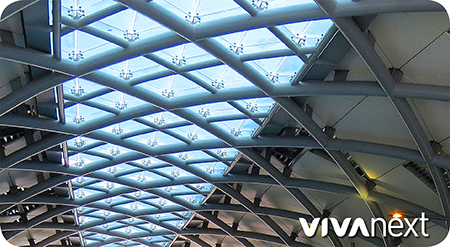
Now, before you think we’ve imported some exotic tropical arachnids, what we call “spiders” are actually the stainless steel fittings that hold together the glass pieces on our stations. They’re called spiders due to their shape, and they play a critical role in the architectural and structural design of our stations.
For the new Vaughan Metropolitan Centre [VMC] rapidway station, the main structural support comes from the welded steel superstructure that forms the distinctive curved shape. Over top of that, steel, custom-made spider fittings are bolted to each steel intersection. The spider fittings support the individual glass panels on the station’s sides and skylight.
410 panels of glass
Each triangular-shaped panel of glass is attached by brackets on the legs of the spiders. Because each piece of glass is a unique size and shape, the job of attaching the glass to the spiders is very fiddly. The extra-large 50 by 24 metre VMC canopy has an eye-popping 410 panels, each equally spaced and slightly different due to the station’s curved planes. The tempered glass can’t be cut or drilled on site without shattering, so holes for the brackets were made during the fabrication process.
beautiful precision
We knew if the holes in the glass didn’t line up exactly to the spider brackets, the glass pieces wouldn’t fit. Since glass fabrication is a fairly slow process, we didn’t want to risk having to go back and remake a piece. Rather than making the glass in advance, we installed the spiders, then measured them with a 3-D laser scanner that registered the targets as multiple cloud points; essentially the same process used to make a 3-D model.
The last step was the installation of the glass panels to the station roof, and seeing all this precision and planning come together for beautiful results. Now if you visit the VMC rapidway station, you can take shelter under a strong and stunning glass canopy reminiscent of the great European architectural traditions, right here in York Region.
